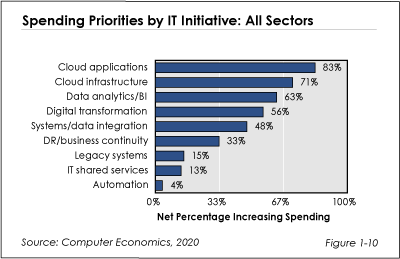The COVID-19 pandemic and ensuing recession have affected IT budgets and forced IT organizations to scramble to deal with remote work and new business processes. Many new projects are being delayed. But despite the changes, IT leaders for the most part will only be tweaking their IT spending priorities around the edges. For several years now, the cloud, business analytics, and digital transformation have been top priorities for IT leaders. In fact, IT organizations that have been treating these as strategic initiatives are now in a much better place to weather the storm.
As shown in Figure 1-10 from the free executive summary of our IT Spending and Staffing Benchmarks 2020/2021 study, cloud applications were the highest spending priority with a net 83% of companies increasing their spending. Second was cloud infrastructure at 71%, followed by data analytics/business intelligence at 63% and digital transformation rounding out the top four at 56%. The lowest priorities were replacing legacy systems at 15%; IT shared services at 13%; and only a net of 4% of companies were increasing spending on IT automation.

For the most part, the current crisis is accelerating technology trends that were already under way. Entertainment companies are expanding their digital platforms to stream products that otherwise would be shown in movie theaters. Doctors are making greater use of telehealth to continue to see patients without exposing them to the coronavirus. Some supply chains have proven to be amazingly robust, switching in a matter of weeks to distributing the majority of food and other supplies from commercial food service to consumer sales channels, for example. Shelves that were frighteningly empty of toilet paper and hand sanitizer are now full again (or relatively so).
“Our survey indicates that, because of the pandemic, many companies may not be able to follow through on all of their new projects, at least for now” said David Wagner, senior research director at Computer Economics, a service of Avasant Research, based in Los Angeles. “But the trends are likely to hold. The economic benefits of the cloud are well known, and digital transformation is driving the business in these uncertain times.”
The pandemic’s full impact on IT spending, especially new projects is not yet known and will vary significantly by sector and digital capabilities. But for the most part, IT organizations can be cautiously optimistic that they are in a better situation than they were during the Great Recession in 2008. In fact, our survey of the impact of the pandemic on IT spending indicates that shows that most organizations have not yet committed to IT budget cuts for 2020. This means that if business bounces back we could see many of those top priority initiatives restarted with vigor.
The Computer Economics IT Spending and Staffing Benchmarks 2020/2021 study is based on a detailed survey of more than 233 IT executives in the U.S. and Canada on their IT spending and staffing plans for 2020/2021. It provides IT spending and staffing benchmarks for small, midsize, and large organizations and for 28 sectors and subsectors. A description of the study’s metrics, design, demographics, and methodology can be found in the free executive summary.
This Research Byte is a brief overview of the findings in our report, IT Spending and Staffing Benchmarks 2020/2021. The full 31-chapter report is available at no charge for Computer Economics clients. Individual chapters may be purchased by non-clients directly from our website (click for pricing).



